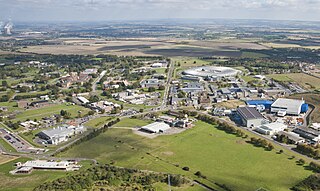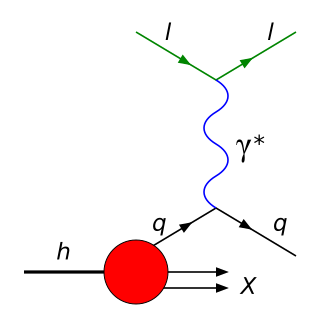Related Research Articles

Crystallography is the experimental science of determining the arrangement of atoms in crystalline solids. Crystallography is a fundamental subject in the fields of materials science and solid-state physics. The word crystallography is derived from the Ancient Greek word κρύσταλλος, with its meaning extending to all solids with some degree of transparency, and γράφειν. In July 2012, the United Nations recognised the importance of the science of crystallography by proclaiming that 2014 would be the International Year of Crystallography.

A muon is an elementary particle similar to the electron, with an electric charge of −1 e and a spin of 1/2, but with a much greater mass. It is classified as a lepton. As with other leptons, the muon is not thought to be composed of any simpler particles; that is, it is a fundamental particle.

Particle physics or high-energy physics is the study of fundamental particles and forces that constitute matter and radiation. The fundamental particles in the universe are classified in the Standard Model as fermions and bosons. There are three generations of fermions, although ordinary matter is made only from the first fermion generation. The first generation consists of up and down quarks which form protons and neutrons, and electrons and electron neutrinos. The three fundamental interactions known to be mediated by bosons are electromagnetism, the weak interaction, and the strong interaction.

Timeline of microscope technology

Small-angle neutron scattering (SANS) is an experimental technique that uses elastic neutron scattering at small scattering angles to investigate the structure of various substances at a mesoscopic scale of about 1–100 nm.

Neutron diffraction or elastic neutron scattering is the application of neutron scattering to the determination of the atomic and/or magnetic structure of a material. A sample to be examined is placed in a beam of thermal or cold neutrons to obtain a diffraction pattern that provides information of the structure of the material. The technique is similar to X-ray diffraction but due to their different scattering properties, neutrons and X-rays provide complementary information: X-Rays are suited for superficial analysis, strong x-rays from synchrotron radiation are suited for shallow depths or thin specimens, while neutrons having high penetration depth are suited for bulk samples.

The Rutherford Appleton Laboratory (RAL) is one of the national scientific research laboratories in the UK operated by the Science and Technology Facilities Council (STFC). It began as the Rutherford High Energy Laboratory, merged with the Atlas Computer Laboratory in 1975 to create the Rutherford Lab; then in 1979 with the Appleton Laboratory to form the current laboratory.

In particle physics, deep inelastic scattering is the name given to a process used to probe the insides of hadrons, using electrons, muons and neutrinos. It was first attempted in the 1960s and 1970s and provided the first convincing evidence of the reality of quarks, which up until that point had been considered by many to be a purely mathematical phenomenon. It is an extension of Rutherford scattering to much higher energies of the scattering particle and thus to much finer resolution of the components of the nuclei.

Muon spin spectroscopy, also known as µSR, is an experimental technique based on the implantation of spin-polarized muons in matter and on the detection of the influence of the atomic, molecular or crystalline surroundings on their spin motion. The motion of the muon spin is due to the magnetic field experienced by the particle and may provide information on its local environment in a very similar way to other magnetic resonance techniques, such as electron spin resonance and, more closely, nuclear magnetic resonance (NMR).
In physics, Larmor precession is the precession of the magnetic moment of an object about an external magnetic field. The phenomenon is conceptually similar to the precession of a tilted classical gyroscope in an external torque-exerting gravitational field. Objects with a magnetic moment also have angular momentum and effective internal electric current proportional to their angular momentum; these include electrons, protons, other fermions, many atomic and nuclear systems, as well as classical macroscopic systems. The external magnetic field exerts a torque on the magnetic moment,

The ISIS Neutron and Muon Source is a pulsed neutron and muon source, established 1984 at the Rutherford Appleton Laboratory of the Science and Technology Facilities Council, on the Harwell Science and Innovation Campus in Oxfordshire, United Kingdom. It uses the techniques of muon spectroscopy and neutron scattering to probe the structure and dynamics of condensed matter on a microscopic scale ranging from the subatomic to the macromolecular.

A neutrino detector is a physics apparatus which is designed to study neutrinos. Because neutrinos only weakly interact with other particles of matter, neutrino detectors must be very large to detect a significant number of neutrinos. Neutrino detectors are often built underground, to isolate the detector from cosmic rays and other background radiation. The field of neutrino astronomy is still very much in its infancy – the only confirmed extraterrestrial sources as of 2018 are the Sun and the supernova 1987A in the nearby Large Magellanic Cloud. Another likely source is the blazar TXS 0506+056 about 3.7 billion light years away. Neutrino observatories will "give astronomers fresh eyes with which to study the universe".

In neutron time-of-flight scattering, a form of inelastic neutron scattering, the initial position and velocity of a pulse of neutrons is fixed, and their final position and the time after the pulse that the neutrons are detected are measured. By the principle of conservation of momentum, these pairs of coordinates may be transformed into momenta and energies for the neutrons, and the experimentalist may use this information to calculate the momentum and energy transferred to the sample. Inverse geometry spectrometers are also possible. In this case, the final position and velocity are fixed, and the incident coordinates varied.

Cargo scanning or non-intrusive inspection (NII) refers to non-destructive methods of inspecting and identifying goods in transportation systems. It is often used for scanning of intermodal freight shipping containers. In the US it is spearheaded by the Department of Homeland Security and its Container Security Initiative (CSI) trying to achieve one hundred percent cargo scanning by 2012 as required by the US Congress and recommended by the 9/11 Commission. In the US the main purpose of scanning is to detect special nuclear materials (SNMs), with the added bonus of detecting other types of suspicious cargo. In other countries the emphasis is on manifest verification, tariff collection and the identification of contraband. In February 2009, approximately 80% of US incoming containers were scanned. To bring that number to 100% researchers are evaluating numerous technologies, described in the following sections.

A neutron research facility is most commonly a big laboratory operating a large-scale neutron source that provides thermal neutrons to a suite of research instruments. The neutron source usually is a research reactor or a spallation source. In some cases, a smaller facility will provide high energy neutrons using existing neutron generator technologies.
Muon tomography or muography is a technique that uses cosmic ray muons to generate two or three-dimensional images of volumes using information contained in the Coulomb scattering of the muons. Since muons are much more deeply penetrating than X-rays, muon tomography can be used to image through much thicker material than x-ray based tomography such as CT scanning. The muon flux at the Earth's surface is such that a single muon passes through an area the size of a human hand per second.
Neutron microscopes use neutrons to create images by nuclear fission of lithium-6 using small-angle neutron scattering. Neutrons also have no electric charge, enabling them to penetrate substances to gain information about structure that is not accessible through other forms of microscopy. As of 2013, neutron microscopes offered four-fold magnification and 10-20 times better illumination than pinhole neutron cameras. The system increases the signal rate at least 50-fold.
Neutrons are spin 1/2 particles that interact with magnetic induction fields via the Zeeman interaction. This interaction is both rather large and simple to describe. Several neutron scattering techniques have been developed to use thermal neutrons to characterize magnetic micro and nanostructures.

Ursula "Uschi" Steigenberger FInstP was a German condensed matter physicist and director of the ISIS neutron source. She was one of the founders of the Institute of Physics Juno Award.
Zoë Althea Bowden is a British physicist and instrumentation scientist who was involved in the construction of the ISIS Neutron and Muon Source. She was awarded an Order of the British Empire in the 2023 New Year Honours in recognition of her services to science.
References
- 1 2 3 4 5 6 7 8 Heirbaut, Jim (22 June 2012). van den Brink, Erwin (ed.). "Neutronenmicroscoop Larmor voor universiteiten" [Neutron microscope for universities]. De Ingenieur (in Dutch). Veen Magazines. 124 (10/11): 7. ISSN 0020-1146. Archived from the original on 21 October 2013. Retrieved 19 July 2012.
- 1 2 "UK-Netherlands collaboration will build neutron super-microscope". ISIS. 22 June 2012. Retrieved 19 July 2012.
- 1 2 "LARMOR Neutron scattering instrument". LARMOR weblog. TU Delft. Retrieved 19 July 2012.
- 1 2 Indra Waardenburg (21 June 2012). "NWO investeert 15,5 mln in apparatuur". Technisch Weekblad. Retrieved 19 July 2012.
- ↑ "Neutron super-microscope to be built at ISIS". Pan European Networks. 25 June 2012. Archived from the original on 31 January 2013. Retrieved 19 July 2012.